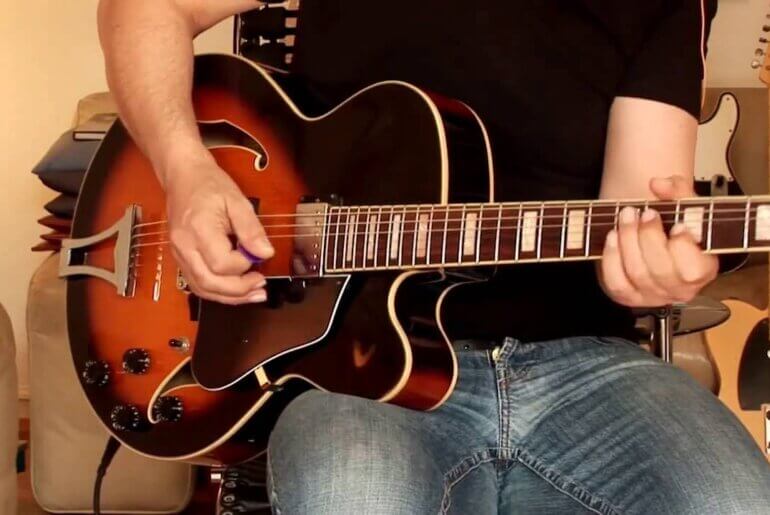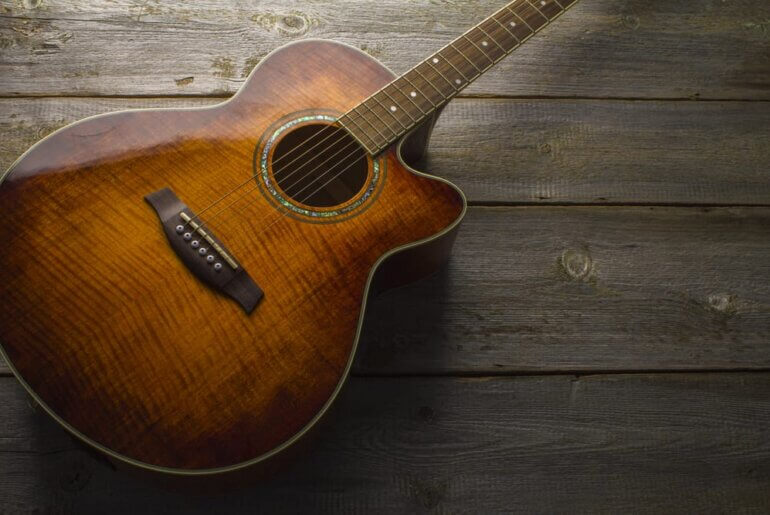Have you found it uncomfortable when learning to play the guitar? Did you check if you have got the right size guitar for your level of expertise? The guitar is a popular instrument. And, people do crave to learn how to play it. However, the confusion about the guitar sizes is very much frustrating. For answering this question, one must know the different standard sizes that are available in every type of guitar.
Be it acoustic, electric, or the bass. There are standard guitar sizes which are available in every type of guitar. One can find various classifications of guitars. One of the most unique ways to classify a guitar is to classify it based upon its sizes. Focusing on guitar sizes is very important. Based on the size of the guitar, its resonance, overall tone, playability, and at the last, comfort, depend. If you are a beginner level guitar player, it is easy to tuck this thought off by think: It won’t matter that much. Think again.
In fact, the thought that the size of a guitar doesn’t really matter much if you are a good guitar player is the mistake the most beginner level guitar player makes. And this mistake often leads to the breaking of interest very soon.
Choosing a guitar that is uncomfortable to hold is one of the chief reasons why beginners find the guitar too difficult to deal with. So, in this guide, we would be also showing you, how size is not only important in terms of comfort but also necessary to play a certain genre. So, let’s dive in and get familiar first with the different sizes that are available in acoustic, electric and bass guitars.
But before we do that, how about getting to know the guitar measurement techniques.
How to Measure a Guitar?
The standard way to do so is by calculating the total length and the scale length of the guitar. The total length is the distance between the two edges of the guitar. However, the scale length is double the measurement between the front edge to the center of the 12th fret.
You can find an elaborate explanation of the same here.
Different Acoustic Guitar Sizes:
Amongst the three most basic types of guitars, acoustic is the one that offers the most amount variations in guitar dimensions. In fact, there are literally 12 different guitar measurements of standard acoustic guitars available in the market for many years. This is eccentric in its own sense because you might get 12 different variations in the size of an electric guitar too. But they are the ones that are customized. For quite some time, these aren’t available for buying as these types of acoustic guitars are. Starting from the smallest type of acoustic guitar:
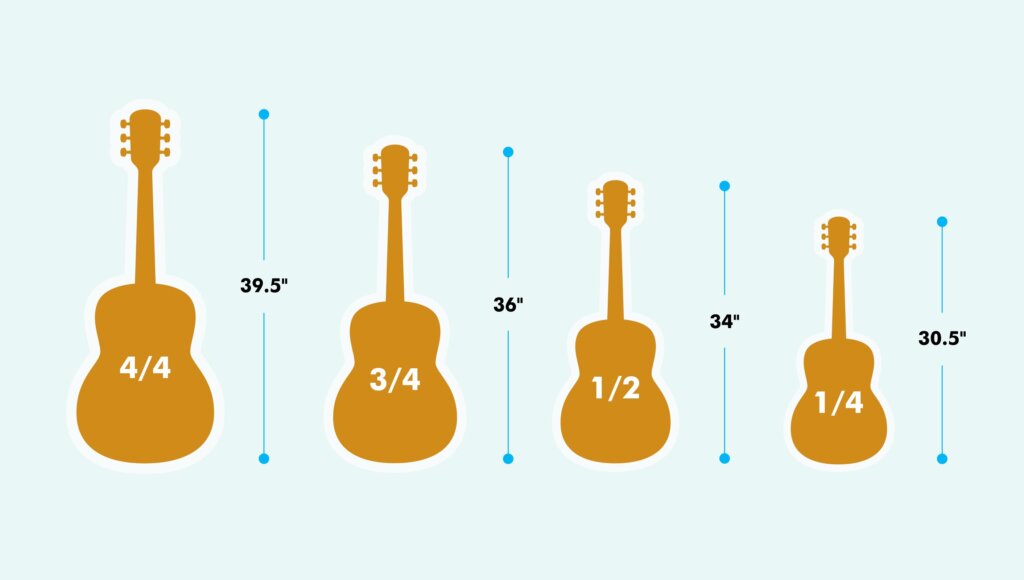
¼ size:
AKA 30 inch guitar, these guitars have a standard scale length of 19 inches. Being the smallest one and the first one on this list, it is easy for you guys to assume that this is the guitar for kids. However, humans are always hungry and looking for doing something different. So, it is not impossible for you to have encountered such kinds of guitars in the hand of many elder ones. In fact, due to the compatibility of these guitars, they are popular among renowned guitar players. Players carry these during world tours or special performances, on stage.
However, it is only known to those expert players of how to play such a small guitar with such huge fingers. Especially when it comes to holding complicated chord positions. On the other hand, if you are a child who has an interest in the instrument or if you have a child who has an interest in the instrument, this is where your search ends. The point to note here is that the name of this guitar might let you conclude that it is quarter the size of a full-sized acoustic guitar. However, that’s not the thing. When it comes to comparing guitar sizes, they are usually compared by the length of their scales. So, if you have concluded, what you shouldn’t please correct yourselves after reading this note.
Recommendations of ¼ acoustic guitars:
- Stagg C505
- Cordoba Protégé Line
- Oscar Schmidt
Recommendations for ¼ electric guitars:
- Lyx Pro Starter
- BCP Starter
- Raptor EP3
If you are shocked to not see any of the famous names in the list of recommendations, no! It’s not any sort of publishing mistake! The fact is: Not a single renowned brand is into the manufacturing of ¼ acoustic guitars. However, you are well aware of the truth that renowned doesn’t mean the best. And this cliché goes completely when it comes to reading recommendations of ¼ guitars. Also, yes! ¼ size is not just available in acoustic guitars, your derivation after seeing recommendations for ¼ electric guitars is right.
The size is also available in electric guitars. However, because this size is typically small and designed especially for kids. And it is a tacit truth that bass is something that is learned only after learning acoustic and electric in general! This size is not available in bass guitars. Now that you have had enough about ¼ size, let’s jump on to the most favorable size amongst kids i.e. ½ size.
½ size:
33 to 34 inch in its full length and 22-23 inch in its scale length, ½ size guitars are generally purchased by parents of those kids who haven’t yet realized the potential in their kids. So basically, they are still checking, whether their kids are just experimenting with their hobbies or are seriously interested and passionate about guitar playing. Because the ¼ size offers more crisp and harsh sound than ½ sized guitars, ½ are more recommended. Pretty much the offering in this size is nylon string, which makes the sound a little bit more audible compared to the steel strung.
Recommendations for ½ size acoustic guitars:
- Yamaha CGS102A
- Cordoba C1M
- Pyle Junior Guitar
- Oscar Schmidt
Recommendations for ½ size electric guitars:
- SX RST
As in the case of ¼ guitar sizes, ¼ electric guitars’ recommendations don’t feature any famous name of the manufacturer. Whilst, the acoustic ones do have some famous names, ¼ electric guitar is yet to have a famous manufacturer. However, the one that’s mentioned is not that famous in the guitar world overall but is much famous in this guitar sizes. The reason behind its familiarity is believed to be the amplifier and cable offering that is given by the company alongside the guitar. After getting ¼ and ½ at its first and second list, I am assuming that by this time you know that ¾ is on the third.
¾ size:
Till now, the sizes were mostly manufactured for kids and were preferred by adults in the form of fancy. ¾ is the first size which can be preferred by the adults, not in the form of fancy. Their full length is 36 inches long and their scale length is 23 inches long. If there is a student which has an interest in guitars and has a faculty who teaches him a guitar and he is of the age group, say, 10-15 or 15-18 years, he is likely to be recommended with a ¾ size.
This size is the teacher’s favorite size. Not because teachers are paid extra to promote this kind of size or anything of that sort. Generally, this is the size that’s in between the most favored size by professionals and the least favored by them. This, being in the middle characteristic of the size makes it the most compatible ones by the beginners, the intermediates, and the experts. Players with good playability love to manifest their amazing speed on this size, whilst players who are still developing their playability want to practice on it to get to that level.
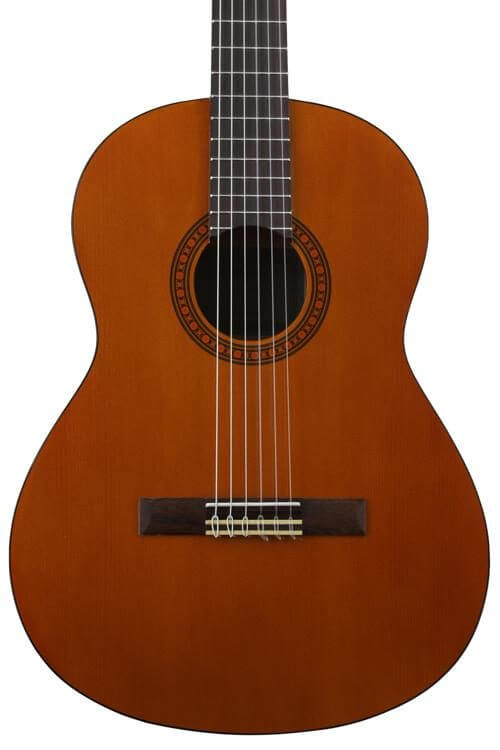
Recommendations for ¾ acoustic guitar sizes:
- Yamaha CGS103A
- Vangoa
- Cordoba Cadete
- Little Martin LX1
- Oscar Schmidt
Recommendations for ¾ electric guitars sizes:
- Squier Mini Strat
- SX RST
- LyxPro 36
Stratocaster fans’ eyes must have found something to cheer for. Yes! ¾ size also marks the entry for Stratocaster guitars. Squier is a brand that has Fender to its name and Fender is such a name that deserves no introduction in the guitar manufacturing field. The company is known to manufacture the best-known guitars that the world currently has. Fender has been the top choice of some of the most legendary guitar players, the world has known and is getting to know.
Recommendations for ¾ bass guitars:
- SX Ursa
- Squier Bronco
- Dean Hillsboro
- Ibanez GSRM20
¾ size also marks the entry of bass guitars. Yeah! As mentioned earlier, the bass is not something that can be easily learned and played. You need to know a little of an acoustic and little bit of electricity to play bass. In fact, some experts even claim that without complete knowledge of acoustic and electric it is impossible to play the bass guitar. So all in all, companies do not manufacture bass guitar based on the same logic that the smaller a player is, the lesser are his/her chances to play bass guitar.
And these manufacturers should be applauded to dare manufacture a product in the domain which they know, is going to be less preferred. From now onwards, the sizes are going to be more preferred by professional guitar players. They are going to full-sized guitars that your eyes encounter much more often than the ones that are mentioned till now. This list starts with…
7/8 size:
We are just one size away to encounter the full-size guitar. These are typically 37 inches when measured fully and 24 when measured scale-ly. It is not difficult to guess that because there is more probability of these guitars being sold to a professional guitar player than a beginner, there are many offerings in this size than compared to others till now. Also, you will find almost all the famous manufacturers’ offerings in this size.
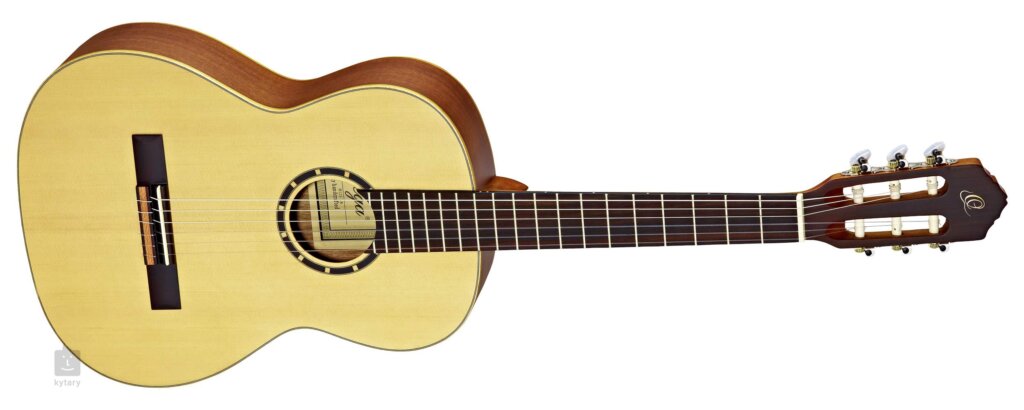
Recommendations of 7/8 size acoustic guitars:
- Cordoba Dolce
- Ortega R121
- Earth 50 OP
Recommendations of 7/8 size electric guitars:
- HS 7/8 size
- SJS 7/8 size
Recommendations of 7/8 bass guitars:
- JBB Viola Bass
After keeping you waited for such long, it’s time to reveal the full-size guitars.
4/4 size (Full Sized) :
The biggest in the industry! Might as well be for the biggest hands in the industry. But that’s not completely correct. Although being favored by some of the biggest hands in the industry, 4/4 is recommended for professionals for a reason. Because these guitars have the highest scale length, they are the ones that also have the highest number of frets. It is because of this reason that they are the most favored by professionals. Having the highest number of frets on the guitar means that one will be able to play the most number of musical notes as well.
Professionals are guitar geeks and they could do anything to play some of the most unknown sounds to enthrall the audience. And because of this reason, they can go to any extent, to ensure that their guitar has the maximum number of scale length possible. This is where 4/4 comes in. And it is because of the same reason that it doesn’t make any sense to make these guitars one of the first that your child can have. Anyways when a beginner guitar player starts playing, he is unknown to the notes and chords which are present on the inner side of the fretboard. So, he/she is likely to take some time to gain the knowledge that it takes to play them. Before gaining that knowledge it would be foolish to own this guitar.
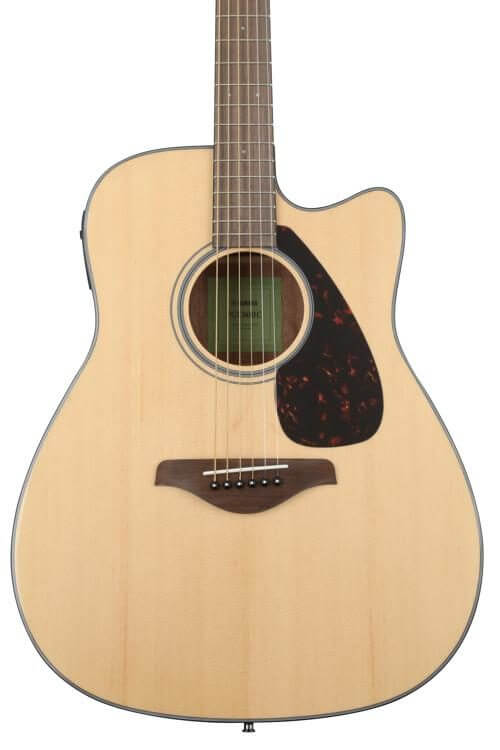
Recommendations of 4/4 acoustic guitars:
- AMD Beginner
- Fender CD-60S
- Yamaha FGX800C
Recommendations of 4/4 electric guitars:
- Squier by Fender Stratocaster
- Epiphone Les Paul
Yes! Fender Stratocaster is a 4/4 guitar. Even Epiphone Les Paul is a name that you should have heard if you are an intermediate level guitar player that loves to keep his list of great guitars that have been manufactured. Both of these guitars have been a standard in the electric guitar industry since electric guitars’ inception. They are old and yet they are preferred by every professional that is currently giving on-stage performances. They are so compatible with playing every genre that they cannot be differentiated. Some experts even say that they are ubiquitous. Having said that about electric guitars, it now time to check out some of the most recommended bass guitar in 4/4 size.
Recommendations of 4/4 bass guitars:
- Gibson Guitars
- Yamaha TRBX504
- Epiphone Jack Casady
Bass Guitar 4/4 size is even more expensive in general than acoustic and electric guitars. This is because of the role for which they are kept in a band. They accompany the rhythm player in the band and make sure that the tempo of the band doesn’t go wrong. However, the fret size of the bass guitar is bigger compared to the electric and acoustic guitar which is also one more reason why you do not get to see a younger one play bass guitar as often as you get to see the other two.
Bass guitars and electric guitars need an amplifier which is also a reason why you don’t get to see every guitar player own an electric or a bass guitar. One needs to spend more than average if he/she owns a bass/ electric guitar which is why, in general, these instruments are only purchased if a player is determined to become a professional guitar player and deliver on-stage performances. These are on average, standard size which you may find while going to purchase a guitar for yourself.
Dreadnaught Guitars:
Dreadnaughts have typically narrower neck, the standard size of which is 43 mm. Now, for whoever who is out there and knows even the slightest bit of acoustic guitar would have heard the name dreadnaught type guitars. These were named after the famous warrior ship HMS and are still the most standard-sized guitar that exists in the market. They are preferred by professionals, but I would argue, not as much as they are preferred by intermediates. They have a slightly narrow head which makes a player easily play the chords on the guitar.
The fact that is interesting about Dreadnaughts is that Martin was the company that introduced this guitar in the 1990s. When they were first introduced they were introduced to break the popularity of that time favorite and the most preferred Guitars. Seeing along all those years that they have spent in the market, it would certainly be worth saying that, the Dreadnaught has certainly broken the popularity of every other type of acoustic guitar available in the market. They have loud sounds and are preferable for rock and pop, country, and bluegrass genres.
I wouldn’t mention recommendations on this one because only dreadnaughts are more famous by the type and not by the manufacturer.
Grand Auditorium and Jumbo:
As the name suggests, they are the most sized acoustic guitars one may possibly find in the market. Their scale length and the full length is the benchmark in the industry that isn’t yet crossed. However, they aren’t as popular as the Dreadnaught acoustics are. The dreadnaughts have a little bit boxy tone which is absent in them. It is because of these boxy tones that the dreadnaughts gained popularity.
And the band mix of instruments gave guitar respect that a lead instrument deserves. This lead to an increase in guitar as a lead instrument. However, the Jumbo and the great auditorium being bigger than the dreadnaught, they prefer strummers of chords and not much leads. This is the reason which makes Jumbo unfavorable for blues and jazz and light country music. One can definitely opt of rock and roll and pop as far as playing on grand auditorium and jumbo is concerned.
After seeing these standard sizes we’d like to answer the question that was mentioned at the start of this guide i.e. how does size affect the overall sound and tone of the guitar?
How to Pick the Right One Among Different Guitar Sizes?
Depending on the size, you can choose the one that set right in your lap, while not seeming uncomfortable while playing. Here is a Guitar Size Chart that you can refer to when buying the right one that fits your comfort level.
| Size | Age / group and level of players that can buy the size |
| 1/4 | Kids (4-7 years old) and beginner level players |
| 1/2 | Kids (7-10 years old), beginner as well as intermediate level players |
| 3/4 | Kids (10-15 years old), Intermediate level players. |
| 7/8 | Kids (15-18 years old), intermediate as well as advanced level players |
| 4/4 | Kids (above 18 years age), advanced level players as well as experts. |
| Dreadnaught | Beginner, intermediate, advanced level players and experts. |
| Grand Auditorium And Jumbo | Intermediate, advanced and expert level players. |
The Conclusion
Apart from this list, there are also some of the small guitars and bigger guitars in existence. However, this list tries to mention the most general options available from the all. The other ones that are absent purposely on this list are the ukuleles, the guitarless, and the parlor. And, few others. For instance, there is also something called travel guitar and the grand concert.
However, these guitars have not got as strong and good past as much as the ones mentioned in this list have got. Also, the ones that aren’t mentioned are much manufactured and often are customized guitars. However, this guide means to give you a general classification of acoustic, electric, and bass guitar based on their sizes.
So that one can decide which one to choose, according to his/her age and level of playability. The section above also means to inculcate and falsify the general on-going theory inside the mind-set of every beginner. To eliminate the myth that size has got nothing to do with the tone or overall sound of the guitar. So, be wise while choosing your one and hope the recommendations are helpful as well. You can find out very well which one of the guitar sizes would fit your needs.

